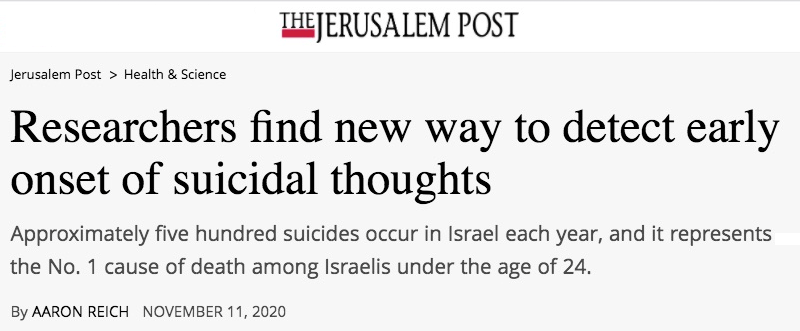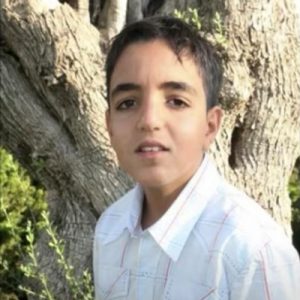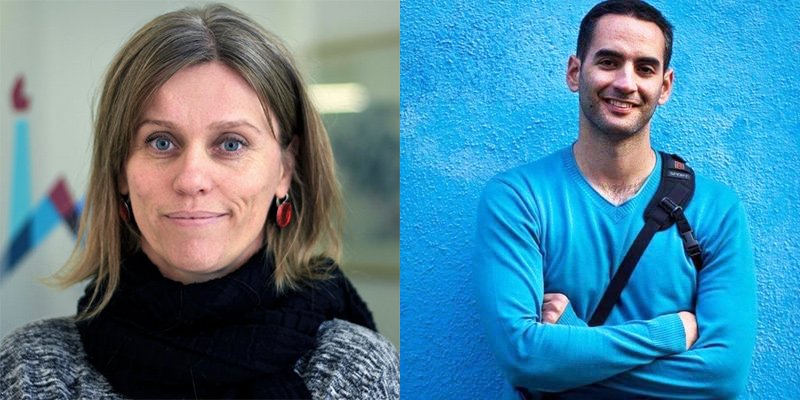

Researchers from Technion-Institute of Technology and the Hebrew University of Jerusalem have developed an innovative technology that can detect early onset of suicidal thoughts and tendencies.
Approximately five hundred suicides occur in Israel each year, and it represents the No. 1 cause of death among Israelis under the age of 24. While psychological and psychiatric health can prove effective, this only applies in situations where the issue has been diagnosed and is being treated. But suicidal tendencies can still go unrecognized in the general population, and as many at-risk people don’t seek help and mental health records remain classified by confidentiality regulations.
It is for this reason that many efforts have been made over the last 50 years in developing models for the early detection of suicidal tendencies, but these models have mainly been based on traditional statistics and were essentially as accurate as chance-level predictions.
But this new study may have just made a major breakthrough.
The research – published in the academic journal Scientific Reports and led by Technion researchers Prof. Roi Reichart, Dr. Yaakov Ophir and PhD candidate Refael Tikochinsky along with Hebrew University’s Prof. Christa Asterhan and Dr. Itay Sisso – has led to the development of a system that combines machine learning, natural language processing and psychological and psychiatric analytical tools with a layered neural network. This combination of tools and methodologies allows for detection of early onset suicidal tendencies in the general population, rather than just those seeking mental health care.
Rather than simply working to detect classic red-flag terms in social media posts like “death” or “suicide,” the researchers understood that other terms were more common. These included negative descriptive terms, curses, terms referring to emotional distress and negative physiological states. This is in stark contrast to those who do not have any suicidal tendencies, as these people typically use more positive emotional expressions, make religious references and have more optimistic views on life.
“We now understand that detecting suicidal tendencies cannot depend only on explicit expressions of distress (such as: ‘I want to die’) or on official medical records such as physiological data from brain scans, psychiatric evaluations, and other data from medical files,” Reichart explained in a statement.
“Attempts to predict suicide attempts based on demographic, psychological, and medical data have not been particularly successful despite five decades of intensive research. Therefore, we realized that we had to approach the challenge from different directions simultaneously.”

The research was motivated following the suicide of 16-year-old David-El Mizrachi, a victim of bullying online and in person.
“It quickly became apparent that detecting suicidal tendencies early enough requires interdisciplinary research that includes researchers from different fields,” Ophir explained.
“That is how this multi-university and multi-disciplinary group was formed.”
In total, the researchers analyzed over 80,000 Facebook posts written by adults in the US and compared the language used with scores on various psychological indices.
“The power of the natural language processing-based algorithm lies in its ability to analyze enormous quantities of linguistic clues – something that humans are not able to do,” Tikochinski said.
“In this project, we integrated cutting-edge attention-based neural network modeling for text representation, with layered neural networks for classification.”

Asterhan added that, “This research has very important applications for identifying people in distress and providing help on time. Furthermore, it demonstrates the strength of intensive multidisciplinary collaboration and of combining advanced knowledge from the social sciences and data sciences. On the one hand, using advanced computational techniques has opened up new research opportunities in the social sciences that were hitherto not possible. On the other hand, the substantial improvement in precision rates was obtained when psychopathological knowledge and data was embedded in the computational models.”
“I have a problem with clichés,” Ophir concluded. “But in this case I believe that, at the end of the day, the breakthrough we achieved is capable of saving lives. I hope that this research is a harbinger of hope in the field of mental health.”
These findings are especially relevant, following a recent Health Ministry report found a 71.2% increase in referrals of children and adolescents with serious suicidal thoughts to mental health clinics amid the coronavirus pandemic.
Almost 39% of patients reported some increase in suicidal thoughts, while another 32% said that they had had a meaningful increase in suicidal thinking. Given that it generally takes between eight months to a year before newly referred patients can see a therapist, the high numbers of suicidal children and adolescents seeking care is worrisome.
Suicide remains a serious problem, including among new immigrants, who often face many barriers in receiving the mental healthcare they need. However, the organizations who help them are often underfunded, with the Knesset Aliyah, Absorption and Diaspora Committee chair MK David Bitan saying that the Health Ministry has failed to transfer NIS 17 million of funds for this purpose.